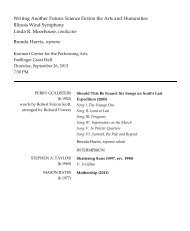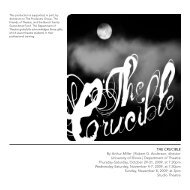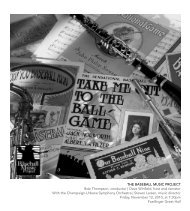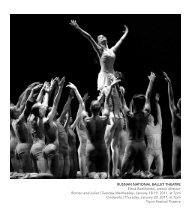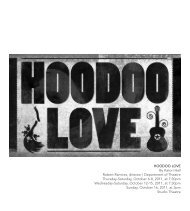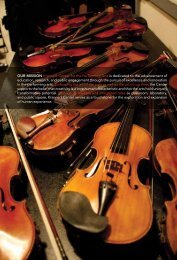Program - Krannert Center for the Performing Arts
Program - Krannert Center for the Performing Arts
Program - Krannert Center for the Performing Arts
- No tags were found...
Create successful ePaper yourself
Turn your PDF publications into a flip-book with our unique Google optimized e-Paper software.
Scene BreakdownTime:Turn of <strong>the</strong> twentieth centuryDramaturg’s noteApproaching a New Century, Reviving Old MonstersPlace:Act IHeartwood House, Whitby, EnglandStoneyfields Asylum, LondonDracula’s Castle20-minute intermissionAct IIThis production includes haze effects.Produced by arrangement with Nick Hern Books.Liz Lochhead’s Dracula is one of many adaptationsof Bram Stoker’s gothic novel that captured <strong>the</strong>concerns of fin de siècle England. Stoker was wellacquainted with <strong>the</strong> major trends and anxieties of histime and adapted his text <strong>for</strong> <strong>the</strong> stage soon after itwas published in 1897. There is something incredibly<strong>the</strong>atrical about this story of an old vampire travelingto England to terrorize <strong>the</strong> modern world. It isboth thrilling and challenging to see Victorian menand women fight against an old terror like Draculadespite <strong>the</strong>ir modern, scientific mind-sets. In heradaptation from 1985, Liz Lochhead moves beyond<strong>the</strong> kitsch that many recent interpretations embraceto revive <strong>the</strong> transgressive potential of Stoker’soriginal story. She exposes <strong>the</strong> sexual tension andclass conflict that remain just under <strong>the</strong> surface of <strong>the</strong>original text.Liz Lochhead emerged as a rare female presenceamong <strong>the</strong> talented Scottish writers of <strong>the</strong> early1970s. Her work often addresses questions ofScottish national identity and challenges traditionalgender expectations. She wants to make space <strong>for</strong>women to tell stories, a role often reserved <strong>for</strong> menin Scotland. In Dracula, Lochhead places women ando<strong>the</strong>r seemingly powerless and displaced charactersat <strong>the</strong> center of <strong>the</strong> narrative, giving <strong>the</strong>m voicesand agency in this story. For example, Mina and Lucyeach display great potential <strong>for</strong> love and power, butthis potential is violently suppressed by Victoriansocial expectations. Dracula reveals <strong>the</strong> dangerinherent in this suppression and pushes his victims toembrace <strong>the</strong>ir potential <strong>for</strong> good and bad.However, Mina and Lucy are not just victims. Theyalso are instigators. Lochhead has said that she wasdrawn to <strong>the</strong> vampire tale by Rule One <strong>for</strong> becomingDracula’s victim: “First of all, you have to invite himin.” These women desire <strong>the</strong> sexual freedom andpower Dracula offers. They are complicit in <strong>the</strong>exchange. Lucy desires an adult sexual relationshipand takes dangerous steps to fulfill her desire. Minadesires a relationship of equals with men, but sheis denied this by traditional social expectations.Dracula’s presence pushes <strong>the</strong>se women to follow<strong>the</strong>ir desires, which initiates powerful changes in <strong>the</strong>social hierarchy that Dracula may not fully appreciate.Lochhead explores class as well as gender through<strong>the</strong> maid, Florrie, who is limited by both her genderand her social position. While Mina expresses adesire to treat Florrie as an equal—by asking her tosimply call her “Mina” not “miss”—Florrie recognizesthat some social divides remain despite <strong>the</strong> rhetoricMina uses. Mina still gives <strong>the</strong> orders. In this society,Lochhead demonstrates that social mobility isprimarily open to men. Arthur Seward gained statusthrough hard work in school to become a doctor.Mina and Lucy’s fa<strong>the</strong>r gained status as a wealthybusiness owner.Lower in status even than <strong>the</strong> women in this Victorianworld is <strong>the</strong> psychiatric patient, Renfield. He hasless potential <strong>for</strong> mobility than anyone else in thisplay. Lochhead captures Stoker’s exploration ofninteenth-century mental health facilities—places inwhich science greatly outweighed humanity. Renfieldis barely regarded as a human being. Nurses in <strong>the</strong>asylum treat him like an animal, so Renfield respondsby acting like one. Seward dismisses Renfield’swarnings and pleas <strong>for</strong> help, considering him nomore than a scientific experiment. His potential<strong>for</strong> good is ignored, and Dracula exploits onlyRenfield’s negative qualities. There remain seeminglyimpassable divides in this society despite <strong>the</strong> promiseof a new age of science, exploration, and equality.8 9




